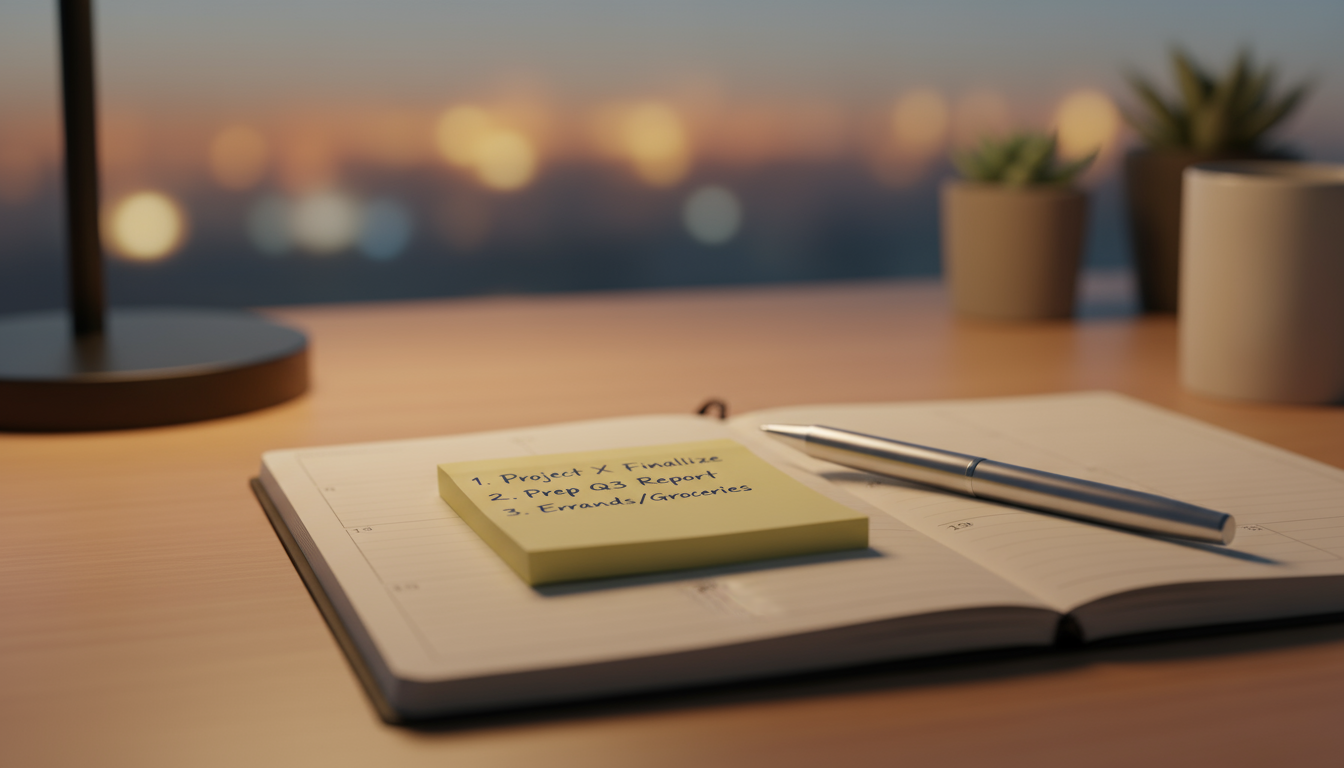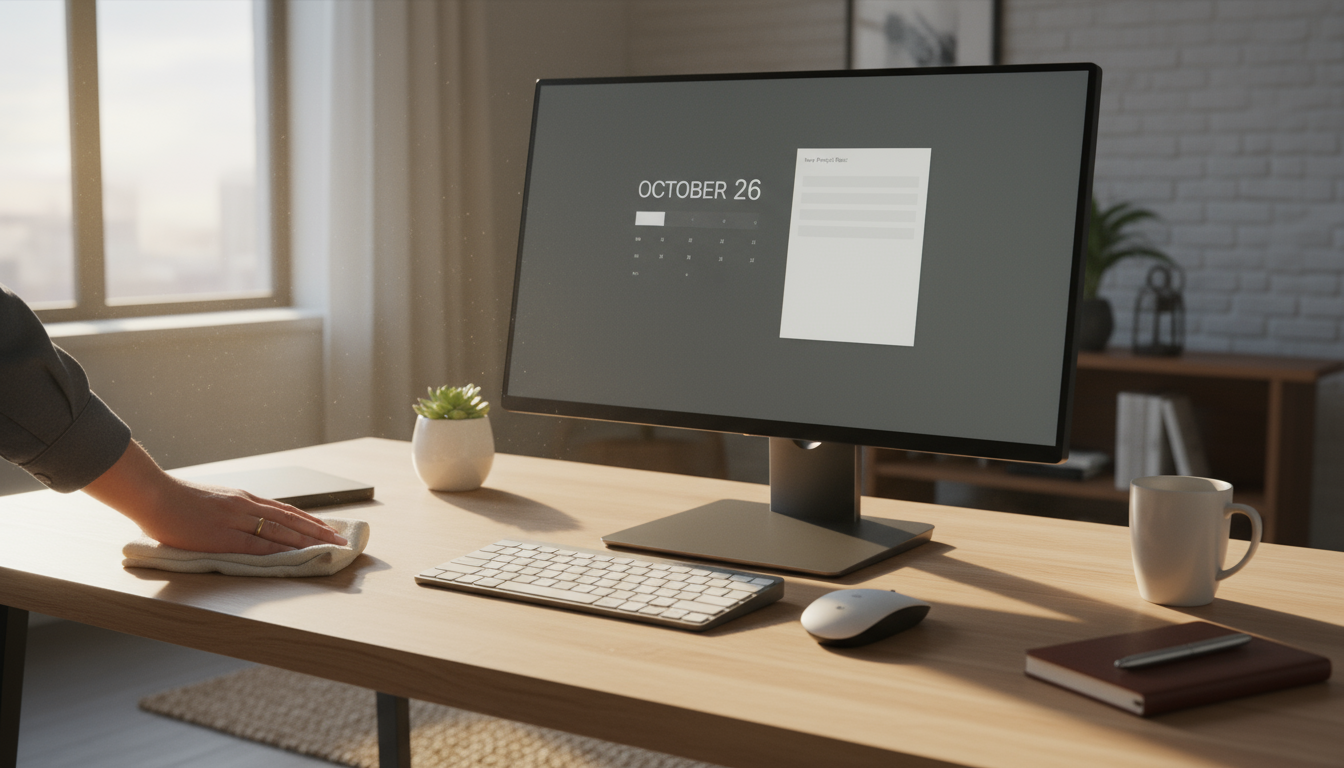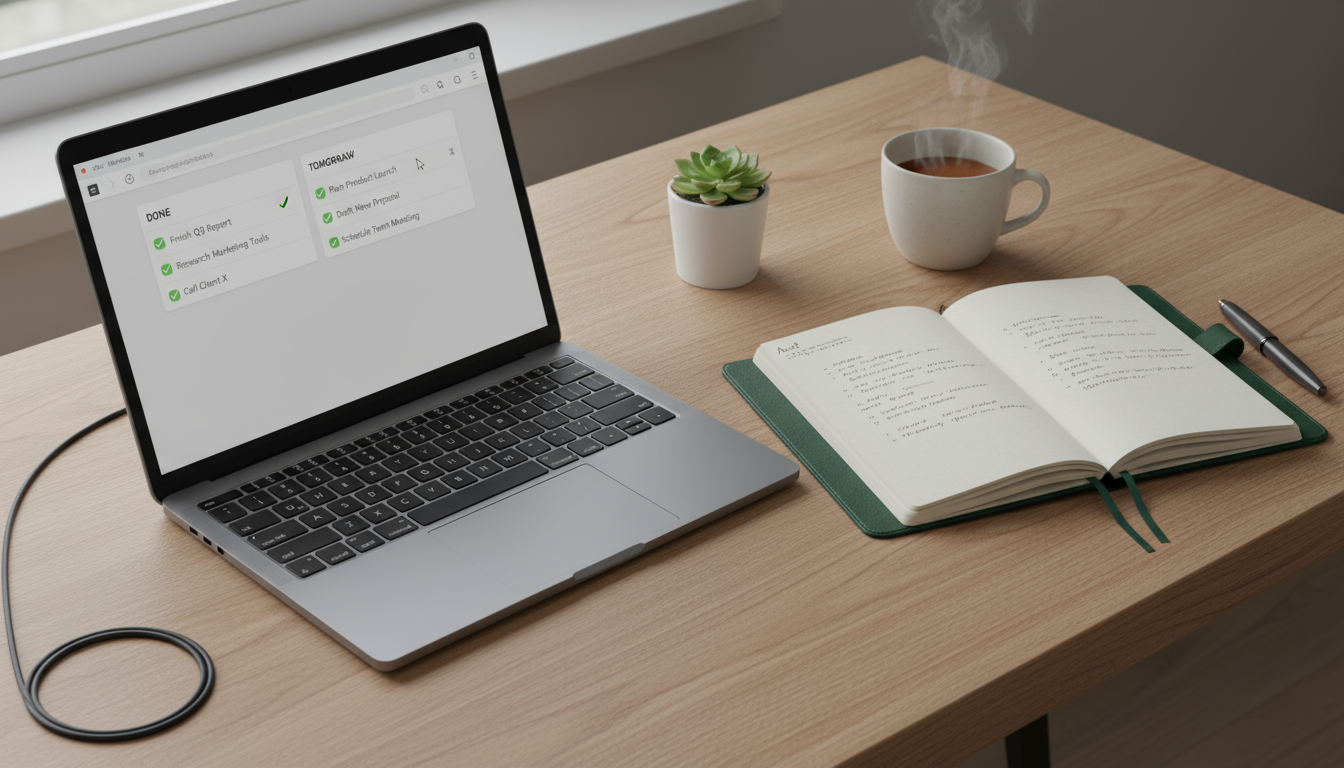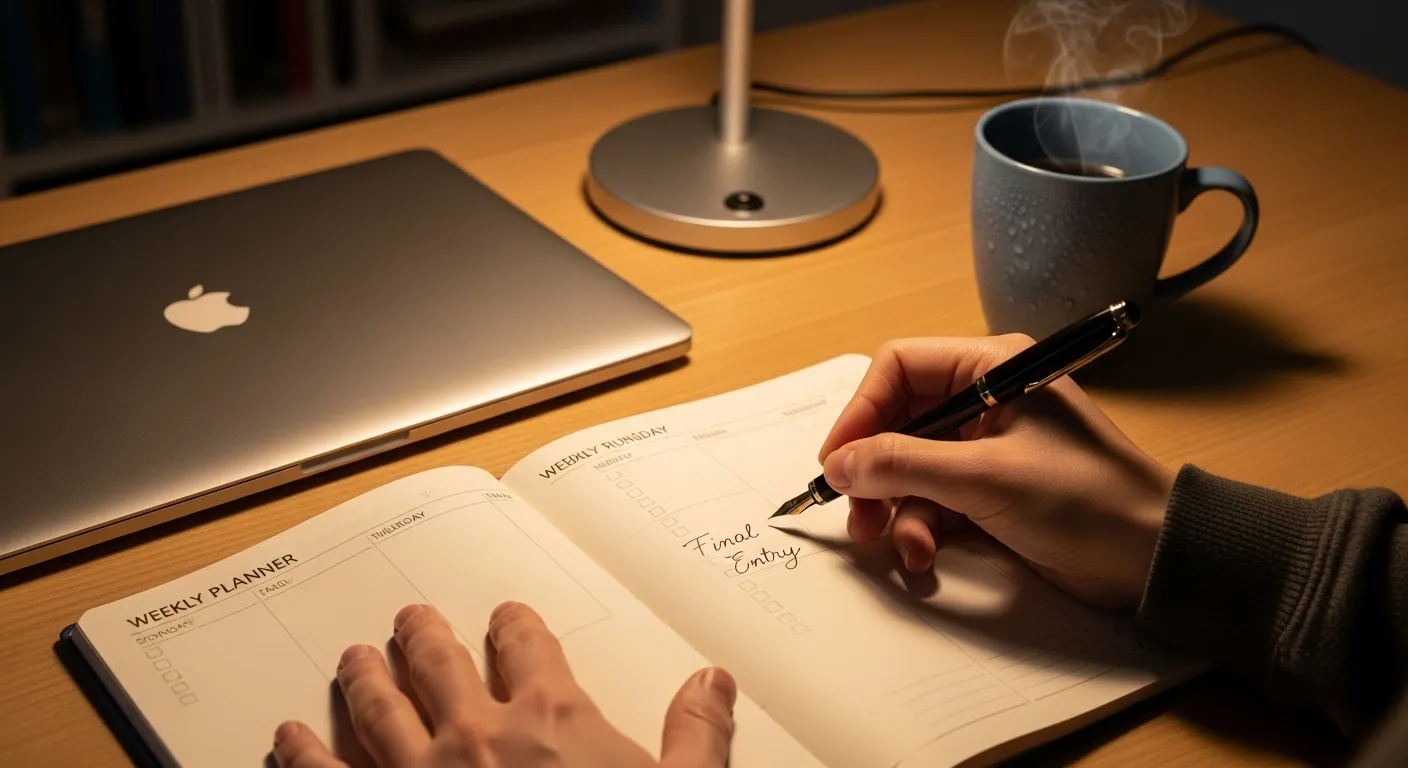
The final email is sent. The last video call has ended. Yet, you’re still mentally at your desk. You’re making dinner, but your mind is replaying a difficult conversation with a client. You’re trying to relax with a book, but you’re secretly outlining a project plan in your head. In a busy city, where the lines between work and home blur into a single, continuous hum of activity, this feeling is more than common; it’s the default. The workday doesn’t end when you close your laptop. It ends when your brain finally gets the message.
This persistent mental chatter is a fast track to exhaustion. It erodes your personal time, strains your relationships, and slowly chips away at your well-being. You know you need structure, but rigid, hour-by-hour schedules often feel brittle and unrealistic. Life happens. A train is delayed. A “quick question” from a colleague turns into a 45-minute problem-solving session. You need a system that bends without breaking. A system that provides a clear, definitive end to your professional obligations so you can fully embrace your personal life.
This is where the workday shutdown ritual comes in. It’s not another complicated productivity hack. It’s a simple, powerful sequence of actions that acts as a psychological buffer between your work self and your home self. It’s a clear signal to your brain that the day’s professional duties are complete, and it is now safe to power down. This article will guide you through creating and implementing a shutdown ritual that helps you reclaim your evenings, achieve true work life balance, and serves as your most effective tool for burnout prevention.
📚 Table of Contents
- What Exactly Is a Workday Shutdown Ritual?
- Setting Up Your Shutdown Ritual: The 5 Essential Steps
- Step 1: Tidy Your Physical and Digital Workspaces
- Step 2: Review and Process Your Inboxes
- Step 3: Update Your Master Task List
- Step 4: Plan Tomorrow’s Top Priorities
- Step 5: Articulate the “Closing Phrase”
- A Day in the Life: Executing Your Ritual with Precision
- Real-World Guardrails: How to Handle Interruptions and Overruns
- Optimizing Your Ritual: The Weekly Review and Key Metrics
- Real-World Scenarios: Applying the Shutdown Ritual
- Frequently Asked Questions About the Shutdown Ritual
- Your Next Steps: Start Your Shutdown Ritual This Week

What Exactly Is a Workday Shutdown Ritual?
At its core, a workday shutdown ritual is a consistent series of small tasks you perform at the very end of your workday to disengage from your professional responsibilities. Think of it as a pre-flight checklist for your evening. Just as a pilot goes through a specific sequence to secure an aircraft, you go through a sequence to secure your mind, ensuring no lingering work-related thoughts follow you into your personal time. This isn’t about working longer; it’s about finishing smarter.
The power of the ritual lies in its psychological impact. Our brains are wired to fixate on incomplete tasks. This phenomenon, known as the Zeigarnik effect, is why you can’t stop thinking about that one unanswered email or the presentation you still need to tweak. A proper shutdown ritual addresses these open loops directly. By reviewing what you’ve done, capturing outstanding tasks, and making a clear plan for tomorrow, you effectively tell your brain, “I’ve handled this. There’s a plan. You can let it go now.” This provides a sense of closure that is essential for mental relaxation.
Furthermore, this practice is a powerful guard against Parkinson’s Law, the adage that work expands to fill the time allotted for its completion. Without a firm endpoint, work can bleed into every available moment of your evening. A shutdown ritual creates a hard stop. It forces you to prioritize what truly matters during the day because you know there’s a definitive finish line. This is a cornerstone of effective time management and a crucial strategy for how to avoid burnout. It’s not about finding more hours in the day; it’s about protecting the hours that belong to you.
Many people struggle with context switching, which is the mental cost of shifting your attention from one task to another. Moving from “work mode” to “home mode” is one of the most significant context switches we make. Without a deliberate process, the transition is messy. You bring work stress to the dinner table and home distractions to your work. A ritual smooths this transition, making it a clean, intentional break instead of a gradual, anxiety-ridden fade-out.

Setting Up Your Shutdown Ritual: The 5 Essential Steps
Creating your personal shutdown ritual doesn’t need to be complicated. The goal is consistency, not complexity. It should take no more than 15-20 minutes. Here are five foundational steps you can adapt to build a routine that works for you. The key is to perform them in the same order every day to build a powerful habit.

Step 1: Tidy Your Physical and Digital Workspaces
A cluttered desk leads to a cluttered mind. Before you finish, take two minutes to reset your environment. Physically, this means putting away papers, wiping down your desk, and organizing your pens. Digitally, it means closing all unnecessary tabs and applications. Leave open only what you need to start tomorrow morning. This simple act of resetting your space creates a sense of order and makes starting the next day feel fresh and focused, rather than chaotic and overwhelming.

Step 2: Review and Process Your Inboxes
Your inboxes (email, Slack, Teams, etc.) are a major source of open loops. Do a final, quick scan. This is not the time to write long replies. The goal is to ensure no true emergencies have been missed. If something can be answered in two minutes or less, do it. For anything else, either convert it into a task on your to-do list for tomorrow or archive it. Reaching “inbox zero” isn’t the goal; achieving “inbox clarity” is. You want to leave knowing nothing is on fire.

Step 3: Update Your Master Task List
Look at what you accomplished today. Acknowledge your progress. Then, review your master task list. Did any new tasks come in from your inbox review or meetings? Add them. Are there any tasks that need to be carried over to tomorrow? Move them. This step ensures that no commitment or idea is lost. It transfers the burden of remembering from your brain to your trusted system (whether that’s a digital app or a physical notebook).

Step 4: Plan Tomorrow’s Top Priorities
This is arguably the most critical step for your peace of mind. Based on your updated task list, decide on the 1 to 3 most important things you need to accomplish tomorrow. This is a simplified version of the 1-3-5 rule, focusing only on the absolute must-dos. Write them down on a sticky note or at the top of your daily planner. When you arrive at your desk tomorrow, you won’t waste any mental energy deciding where to start. You’ll already have a clear, concise plan, which significantly reduces morning anxiety and decision fatigue. This proactive approach is a powerful tool for burnout prevention.

Step 5: Articulate the “Closing Phrase”
The final step is to create a verbal or physical cue that signifies the end. As you get up from your desk, say a consistent phrase out loud, like “Work is done for the day” or “Shutdown complete.” It might feel silly at first, but this auditory signal reinforces the boundary you’re creating. It’s a definitive statement to yourself that you are now transitioning out of work mode. Combine this with the physical act of turning off your monitor or closing your laptop. This final, clear action seals the ritual.

A Day in the Life: Executing Your Ritual with Precision
Let’s walk through what this looks like for a busy professional named Maya. Maya lives in the city and has a demanding hybrid role. She uses time blocking, a method where you schedule specific blocks of time for specific tasks, to manage her day.
Her afternoon is packed. From 2:00 to 4:00 PM, she has a block for “Deep Work: Finalize Q3 Report.” At 4:00 PM, a meeting with her team runs until 4:45 PM. Her calendar has a recurring event at 5:00 PM every day simply called “Workday Shutdown.” This 15-minute block is non-negotiable.
At 4:45 PM, the meeting ends. Instead of immediately checking her email again, Maya resists the urge. She takes a moment to stretch. At 5:00 PM sharp, her shutdown alarm goes off. She begins her ritual. First, she tidies her desk, stacking a few papers and putting her notebook away. She closes the 20 browser tabs she accumulated during her research, leaving only her calendar and task manager open. That’s Step 1.
Next, she does a quick scan of her email. She sees a few non-urgent messages and a question from a junior colleague. She quickly replies to her colleague, as it takes less than two minutes. She flags another email, which requires a detailed response, and drags it into her task manager to handle tomorrow. That’s Step 2.
She then opens her task manager. She checks off the “Finalize Q3 Report” task—a satisfying moment. She adds the task “Reply to David about budget” from the email she just flagged. She sees that one of her smaller tasks, “Review marketing copy,” didn’t get done. She drags it to tomorrow’s list without guilt. The system has caught it. That’s Step 3.
Now for the most important part. She looks at tomorrow’s list and identifies her top priority: presenting the Q3 report at the 10:00 AM leadership meeting. She writes on a physical sticky note and places it on her monitor: “1. Prep for 10am presentation.” That’s it. Just one thing, because she knows that’s the task that will deliver the most value, a classic application of the 80/20 principle, where 20% of the effort often yields 80% of the results. That’s Step 4.
Finally, at 5:15 PM, she turns off her monitor, closes her laptop, and says out loud, “And… we are done.” She pushes her chair in and walks away from her desk, leaving work behind completely. She can now focus on her evening commute and her plans to meet a friend for dinner, confident that nothing has been forgotten. This is the essence of a successful shutdown ritual in action.

Real-World Guardrails: How to Handle Interruptions and Overruns
Life is messy, and no system is perfect. The key to a sustainable ritual is having a plan for when things go wrong. Your workday shutdown isn’t a rigid cage; it’s a flexible framework. Here’s how to handle common challenges that threaten to derail your efforts to achieve work life balance.

When Meetings Run Late
It’s 5:10 PM, and your 4:30 PM meeting is still going. Your shutdown alarm has already gone off. Do you panic? No. The rule is simple: start your ritual as soon as the interruption is over. Even if you only have five minutes, do a compressed version. Tidy your desk (1 min), glance at your inbox for emergencies (1 min), and identify tomorrow’s single most important task (1 min). A 3-minute, imperfect ritual is infinitely better than no ritual at all. The goal is to maintain the habit, even if the execution is abbreviated.

Handling Last-Minute “Urgent” Requests
Your boss messages you at 4:58 PM with a request that feels urgent. Before you scrap your shutdown, take a breath and evaluate. Ask clarifying questions: “Is this something you need before you leave today, or can I get it to you first thing in the morning?” You’ll often find that their urgency isn’t as immediate as it sounds. If it truly is an emergency, handle it. Then, perform your compressed shutdown ritual afterward. Over time, as you become known for being organized and reliable during work hours, people will learn to respect your boundaries. Renegotiating expectations is a key skill for long-term burnout prevention.

What if I’m Just Too Tired?
Some days are incredibly draining. The idea of doing even a 15-minute ritual can feel like a monumental effort. On these days, lean on the “minimum effective dose.” What is the absolute bare minimum you can do to signal the day is over? For some, it might just be tidying the desk and writing down one priority for tomorrow. For others, it might be just saying their closing phrase. Don’t let the pursuit of the perfect ritual stop you from doing a good-enough ritual. Consistency trumps intensity every time. The American Psychological Association (APA) notes that stress is often exacerbated by a perceived lack of control. A simple ritual, even a tiny one, can help restore that sense of agency. You can find more on managing stress on the APA’s website at https://www.apa.org/.

Optimizing Your Ritual: The Weekly Review and Key Metrics
A good system evolves. To ensure your shutdown ritual remains effective and serves your goal of how to avoid burnout, you should review it periodically. The best time to do this is during a weekly review, a practice where you spend 30-60 minutes on a Friday afternoon or Monday morning looking back at the past week and planning the week ahead.
During your weekly review, ask yourself a few key questions about your shutdown ritual. Did I consistently perform it each day? Which parts felt helpful? Which parts felt like a chore? Were there any days where it failed, and why? This reflection allows you to fine-tune the steps. Maybe you find that processing your inbox at the end of the day is too stressful. You might experiment with doing it 30 minutes before your shutdown, using the ritual time purely for planning.
To make this review more objective, you can track a few simple metrics. You don’t need fancy software; a simple note will do. Watch these three things:
1. Energy Level at 8 PM: On a scale of 1 to 5, how mentally energized do you feel in the middle of your evening? A low score might indicate that work-related stress is still bleeding through, suggesting your ritual needs to be more robust. The goal of better work life balance is to have the energy for your life outside of work.
2. Rollover Rate: How many tasks from your daily to-do list are consistently being pushed to the next day? A high rollover rate could be a sign of over-scheduling or unrealistic daily planning. Your shutdown ritual’s planning phase can help you address this by setting more realistic priorities for the following day.
3. Deep Work Sessions Completed: Deep work—the ability to focus without distraction on a cognitively demanding task—is crucial for productivity and job satisfaction. A successful shutdown ritual clears your mind, which, according to research from institutions like the National Institutes of Health (NIH), is essential for the restorative processes that improve focus. Check their resources at https://www.nih.gov/. If you find you’re completing more of your planned deep work sessions, it’s a good sign your system is working.
By regularly checking in on these metrics, you can ensure your shutdown ritual is an active, evolving tool that genuinely supports your well-being and productivity, rather than a static checklist you perform on autopilot.

Real-World Scenarios: Applying the Shutdown Ritual
The beauty of the shutdown ritual is its adaptability. It’s a principle, not a rigid prescription. Let’s see how two different people might apply it to their unique circumstances.

Scenario 1: The Hybrid Professional
James works in marketing. He’s in the office three days a week and works from home two days a week. This creates a challenge for consistency. He decides to create two slightly different versions of his ritual.
On office days, his shutdown ritual is tied to his commute. At 5:15 PM, he starts his 15-minute shutdown. He clears his desk, updates his digital task list, and identifies his top priority for the next day, which he writes in a small notebook he carries. His closing phrase is “Okay, office day is done.” The physical act of packing his bag and walking out of the building becomes a powerful final step. The commute itself then serves as a buffer zone, allowing him to decompress before he gets home.
On work-from-home days, the boundary is harder to maintain. His desk is in his living room. He sets a firm 5:30 PM alarm. When it goes off, he performs the same digital cleanup. However, he adds two unique steps. First, he changes out of his “work clothes” (even if it’s just a different t-shirt) to signal a shift in his role. Second, after saying his closing phrase, he takes a 10-minute walk around the block. This mimics the “commute” and creates a physical separation from his workspace, making it easier to return home and not feel like he’s still at the office.

Scenario 2: The University Student
Chloe is a university student juggling classes, a part-time job, and lab work. Her schedule is erratic. “The end of the day” is a moving target. Instead of a single shutdown ritual, she uses “session shutdowns.”
After a 3-hour study session in the library, she takes 5 minutes to perform a mini-ritual. She packs her books neatly, reviews her notes to summarize what she just learned, and checks her planner to see what’s next—a class across campus. Her closing phrase is internal: “Study session complete.” This closes the mental loop on that subject, preventing her from worrying about her chemistry notes during her history lecture. This is a crucial strategy for burnout prevention in an academic setting.
Her true “end of day” shutdown happens after her last academic or work commitment. It might be at 8:00 PM after her shift at the campus cafe. In her dorm room, she takes 10 minutes to review her full schedule for the next day, pack her bag, and lay out her clothes. This preparation reduces morning chaos and ensures she gets enough sleep, which is fundamental to learning and well-being. The Sleep Foundation (https://www.sleepfoundation.org/) consistently highlights the link between consistent sleep schedules and cognitive performance.

Frequently Asked Questions About the Shutdown Ritual
Here are answers to some common questions and concerns people have when first implementing a workday shutdown ritual.
What if my job requires me to be “on call” or check email in the evenings?
If your role truly requires evening availability, your shutdown ritual needs to reflect that. Instead of a full shutdown, you can perform a “checkpoint ritual.” Your ritual’s purpose shifts from “I am completely done” to “I have completed my primary work for the day and am now in monitoring mode.” You would still clean your desk and plan for tomorrow, but you might set specific, short windows (e.g., 10 minutes at 8:00 PM) to check for emergencies, rather than being tethered to your inbox all night. It’s about creating structure and intention around evening work, not eliminating it entirely.
How long should my shutdown ritual take?
Aim for 10 to 20 minutes. If it’s too short, you might not give your brain enough time to process the transition. If it’s too long, it will feel like another burdensome task, and you’ll be tempted to skip it. The sweet spot is a routine that is comprehensive enough to provide closure but brief enough to be sustainable even on the most tiring days.
What if my day is just a string of back-to-back meetings?
On days like these, the shutdown ritual is more important than ever. You likely have dozens of open loops and follow-up tasks. Your ritual might need to focus more heavily on processing and planning. You’ll spend most of the 15 minutes reviewing your meeting notes, extracting action items, adding them to your task list, and then ruthlessly prioritizing what *actually* needs to happen tomorrow versus what can wait. This prevents the post-meeting-marathon feeling of being overwhelmed and unsure where to even begin.
How strict do I need to be? What if I miss a day?
The goal is consistency, not perfection. If you miss a day, don’t worry about it. The worst thing you can do is let one missed day turn into two, then a week. Just pick it back up the next day without judgment. The value of a ritual comes from its repetition over weeks and months. A single slip-up doesn’t erase all the progress you’ve made. Being pragmatic is key to long-term success.
I work from home. How can I create a real sense of separation?
For remote workers, the ritual’s physical components are vital. The act of closing your laptop is not enough. You need to change your physical state or location. This could mean changing your clothes, going for a short walk, moving to a different room to read for 10 minutes, or starting a “commute to home” by listening to a podcast while you prepare dinner. The goal is to create a clear, sensory signal that the workday has concluded and your home life has begun.

Your Next Steps: Start Your Shutdown Ritual This Week
Knowing how to avoid burnout isn’t about grand, sweeping changes. It’s about small, sustainable habits that protect your time and energy. The workday shutdown ritual is one of the most impactful habits you can build to create a healthier, more sustainable relationship with your work.
You don’t need to implement all five steps at once. Start small and build momentum. Here are three simple actions you can take this week to begin.
1. Choose Your Time and Set an Alarm. Look at your schedule and decide on a realistic end time for your workday. Put a recurring 15-minute appointment in your calendar labeled “Workday Shutdown.” Treat it with the same respect you would any other meeting. The alarm is your cue to begin the transition.
2. Define Your Three Core Steps. Start with a simplified version of the ritual. For your first week, commit to just three steps. A great starting combination is: Tidy your digital workspace (close tabs), identify your single most important task for tomorrow, and say your closing phrase as you shut down your computer. You can add more steps later as the habit becomes second nature.
3. Tell Someone About Your Plan. Share your intention with a partner, a friend, or a coworker. This simple act of accountability can dramatically increase your chances of sticking with it. Ask them to check in with you at the end of the week. Knowing someone might ask can be the extra nudge you need to follow through on a busy day.
Your evenings are valuable. Your mental peace is non-negotiable. By implementing a simple shutdown ritual, you are taking a powerful, proactive step towards better work life balance and building a career that energizes you instead of drains you. Start today.
Disclaimer: The information provided in this article is for informational purposes only and does not constitute medical, financial, or legal advice. Please consult with a qualified professional for advice tailored to your specific situation.






